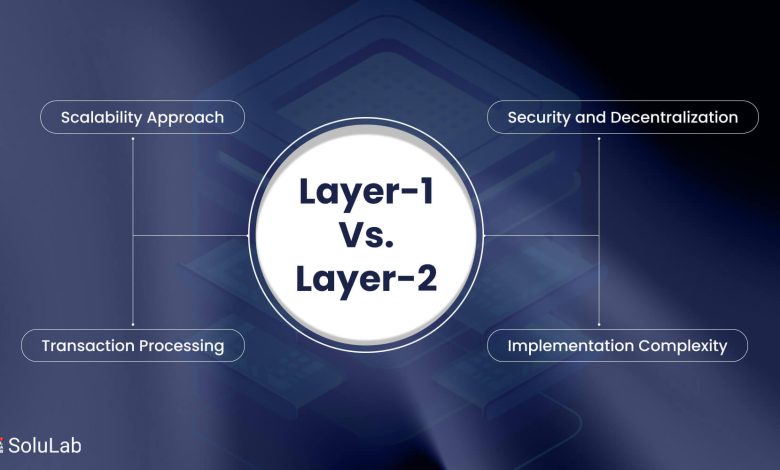Understanding Layer 1 vs. Layer 2 Solutions

- Introduction to Layer 1 and Layer 2 Solutions
- Differentiating Between Layer 1 and Layer 2 Protocols
- Benefits of Layer 1 Solutions in Networking
- Exploring the Functionality of Layer 2 Solutions
- Comparing Performance of Layer 1 vs. Layer 2 Technologies
- Implementing Layer 1 and Layer 2 Solutions in Network Infrastructure
Introduction to Layer 1 and Layer 2 Solutions
Layer 1 and Layer 2 solutions are fundamental components of network architecture that play a crucial role in ensuring efficient data transmission. Layer 1, also known as the physical layer, deals with the actual physical connection between devices, such as cables and switches. On the other hand, Layer 2, or the data link layer, focuses on the logical addressing of devices and the organization of data into frames for transmission.
Layer 1 solutions are primarily concerned with the physical aspects of network connectivity, such as the type of cables used, the distance between devices, and the speed of data transmission. These solutions are essential for establishing a reliable connection between devices and ensuring that data can be transmitted without interference or loss.
Layer 2 solutions, on the other hand, are more focused on the logical aspects of data transmission. This includes addressing devices using MAC addresses, organizing data into frames, and managing how data is transmitted across the network. Layer 2 solutions are crucial for ensuring that data is delivered to the correct destination and that it is transmitted efficiently.
In summary, Layer 1 solutions are concerned with the physical connection between devices, while Layer 2 solutions focus on the logical aspects of data transmission. Both layers play a vital role in ensuring that data is transmitted reliably and efficiently across a network. Understanding the differences between these two layers is essential for designing and maintaining a robust network infrastructure.
Differentiating Between Layer 1 and Layer 2 Protocols
Layer 1 and Layer 2 protocols are fundamental components of network communication. Layer 1 protocols, also known as physical layer protocols, are responsible for the actual physical connection between devices. These protocols define how data is transmitted over cables or wireless signals, including characteristics such as voltage levels, data rates, and modulation techniques. Layer 1 protocols ensure that the signals sent by one device can be correctly interpreted by another device on the network.
On the other hand, Layer 2 protocols, or data link layer protocols, operate at a higher level of abstraction. These protocols focus on how data is formatted for transmission and how devices on the same network can be identified. Layer 2 protocols use MAC addresses to uniquely identify devices on a network and manage the flow of data between them. Ethernet and Wi-Fi are examples of Layer 2 protocols commonly used in networking.
Differentiating between Layer 1 and Layer 2 protocols is crucial for understanding how data is transmitted and received in a network. While Layer 1 protocols deal with the physical aspects of communication, Layer 2 protocols handle the logical organization of data. By grasping the distinctions between these two layers, network administrators can troubleshoot connectivity issues more effectively and optimize network performance.
Benefits of Layer 1 Solutions in Networking
Layer 1 solutions in networking offer several benefits that can enhance the overall performance and efficiency of a network infrastructure. These solutions primarily focus on the physical layer of the network, which involves the actual hardware components and cabling used to transmit data. By optimizing this foundational layer, organizations can experience improved reliability, speed, and scalability in their network operations.
One of the key advantages of Layer 1 solutions is their ability to reduce latency in data transmission. By minimizing the time it takes for signals to travel between devices, these solutions can significantly enhance the speed at which data is transferred across the network. This can lead to faster response times for applications and services, ultimately improving the overall user experience.
Additionally, Layer 1 solutions can help organizations achieve greater reliability in their network connections. By ensuring that the physical components of the network are properly configured and maintained, these solutions can reduce the risk of downtime and connectivity issues. This increased reliability can be especially beneficial for businesses that rely on constant access to their network resources.
Another advantage of Layer 1 solutions is their scalability. As organizations grow and expand their network infrastructure, they need solutions that can easily accommodate increased data traffic and new devices. Layer 1 solutions provide a solid foundation for scalability, allowing organizations to add new hardware components and make changes to their network configuration without disrupting existing operations.
Overall, Layer 1 solutions play a crucial role in optimizing the physical layer of a network and improving its performance and reliability. By leveraging these solutions, organizations can create a more efficient and resilient network infrastructure that meets their evolving needs and supports their business objectives.
Exploring the Functionality of Layer 2 Solutions
Layer 2 solutions are a crucial component in the realm of blockchain technology. These solutions are designed to enhance the functionality of layer 1 protocols by offloading some of the transaction processing from the main chain. By doing so, layer 2 solutions can significantly improve scalability and reduce transaction costs.
One of the key features of layer 2 solutions is their ability to enable faster and more efficient transactions. This is achieved by moving transactions off-chain, where they can be processed more quickly and at a lower cost. Layer 2 solutions also help to alleviate congestion on the main chain, allowing for a smoother and more seamless user experience.
Another important aspect of layer 2 solutions is their support for smart contracts. Smart contracts are self-executing contracts with the terms of the agreement directly written into code. Layer 2 solutions can facilitate the execution of smart contracts by providing a more efficient and cost-effective environment for their operation.
Overall, layer 2 solutions play a vital role in enhancing the functionality of blockchain networks. By improving scalability, reducing transaction costs, and supporting smart contracts, layer 2 solutions help to unlock the full potential of blockchain technology. As the blockchain ecosystem continues to evolve, layer 2 solutions will undoubtedly remain a key focus for developers and users alike.
Comparing Performance of Layer 1 vs. Layer 2 Technologies
When comparing the performance of Layer 1 and Layer 2 technologies, it is essential to consider various factors that can impact network efficiency and reliability. Layer 1 solutions, also known as physical layer technologies, focus on the actual hardware components and physical connections that make up a network. On the other hand, Layer 2 solutions, or data link layer technologies, operate at a higher level and are responsible for data framing, error detection, and flow control.
Layer 1 technologies, such as Ethernet cables and fiber optics, provide the foundation for network connectivity by establishing the physical connections between devices. These technologies offer high-speed data transmission and low latency, making them ideal for demanding applications that require real-time data processing. However, Layer 1 solutions are limited in their ability to manage network traffic and prioritize data packets effectively.
Layer 2 technologies, including switches and bridges, add a layer of intelligence to the network by organizing data into frames and facilitating communication between devices. These technologies offer features such as VLANs, QoS, and MAC address filtering, which help optimize network performance and ensure reliable data delivery. Layer 2 solutions are particularly beneficial in environments where multiple devices need to communicate securely and efficiently.
When comparing the performance of Layer 1 vs. Layer 2 technologies, it is essential to consider the specific requirements of the network and the desired level of control and flexibility. Layer 1 solutions excel in providing fast and reliable connectivity, while Layer 2 technologies offer advanced features for managing network traffic and optimizing data transmission. By understanding the strengths and limitations of each layer, organizations can choose the right technology to meet their networking needs effectively.
Implementing Layer 1 and Layer 2 Solutions in Network Infrastructure
Implementing Layer 1 and Layer 2 solutions in network infrastructure is crucial for ensuring optimal performance and reliability. Layer 1 solutions focus on the physical aspects of the network, such as cables, connectors, and switches. These solutions help establish a solid foundation for data transmission by ensuring that the physical components are in good working condition.
On the other hand, Layer 2 solutions operate at the data link layer and are responsible for organizing data into frames for transmission between devices on the same network. Implementing Layer 2 solutions involves configuring switches, VLANs, and other network devices to facilitate efficient communication between connected devices.
When implementing Layer 1 solutions, it is essential to pay attention to factors such as cable quality, length, and termination. Using high-quality cables and connectors can help minimize signal loss and interference, leading to better network performance. Additionally, ensuring proper cable management and labeling can simplify troubleshooting and maintenance tasks in the future.
For Layer 2 solutions, configuring switches with the appropriate VLANs and implementing protocols like Spanning Tree Protocol (STP) can help optimize network traffic and prevent loops that can cause network downtime. By segmenting the network into smaller broadcast domains, VLANs can improve network security and performance by limiting the scope of broadcast traffic.
In conclusion, implementing both Layer 1 and Layer 2 solutions is essential for building a robust and reliable network infrastructure. By focusing on the physical and data link layers of the OSI model, organizations can create a stable foundation for data transmission and ensure seamless communication between devices on the network.



